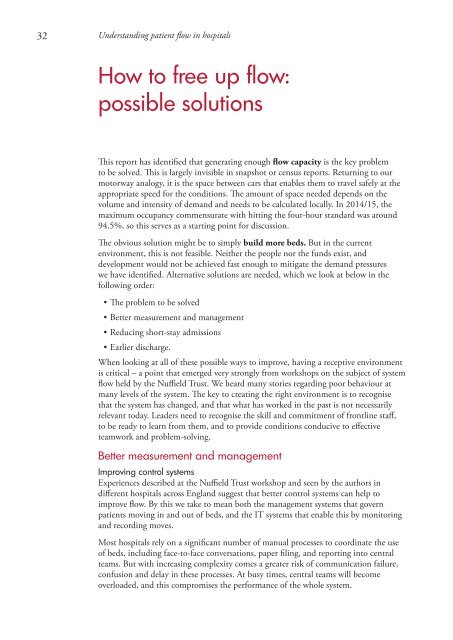Understanding patient flow in hospitals
understanding_patient_flow_in_hospitals_web_0
understanding_patient_flow_in_hospitals_web_0
You also want an ePaper? Increase the reach of your titles
YUMPU automatically turns print PDFs into web optimized ePapers that Google loves.
32 <strong>Understand<strong>in</strong>g</strong> <strong>patient</strong> <strong>flow</strong> <strong>in</strong> <strong>hospitals</strong><br />
How to free up <strong>flow</strong>:<br />
possible solutions<br />
This report has identified that generat<strong>in</strong>g enough <strong>flow</strong> capacity is the key problem<br />
to be solved. This is largely <strong>in</strong>visible <strong>in</strong> snapshot or census reports. Return<strong>in</strong>g to our<br />
motorway analogy, it is the space between cars that enables them to travel safely at the<br />
appropriate speed for the conditions. The amount of space needed depends on the<br />
volume and <strong>in</strong>tensity of demand and needs to be calculated locally. In 2014/15, the<br />
maximum occupancy commensurate with hitt<strong>in</strong>g the four-hour standard was around<br />
94.5%, so this serves as a start<strong>in</strong>g po<strong>in</strong>t for discussion.<br />
The obvious solution might be to simply build more beds. But <strong>in</strong> the current<br />
environment, this is not feasible. Neither the people nor the funds exist, and<br />
development would not be achieved fast enough to mitigate the demand pressures<br />
we have identified. Alternative solutions are needed, which we look at below <strong>in</strong> the<br />
follow<strong>in</strong>g order:<br />
• The problem to be solved<br />
• Better measurement and management<br />
• Reduc<strong>in</strong>g short-stay admissions<br />
• Earlier discharge.<br />
When look<strong>in</strong>g at all of these possible ways to improve, hav<strong>in</strong>g a receptive environment<br />
is critical – a po<strong>in</strong>t that emerged very strongly from workshops on the subject of system<br />
<strong>flow</strong> held by the Nuffield Trust. We heard many stories regard<strong>in</strong>g poor behaviour at<br />
many levels of the system. The key to creat<strong>in</strong>g the right environment is to recognise<br />
that the system has changed, and that what has worked <strong>in</strong> the past is not necessarily<br />
relevant today. Leaders need to recognise the skill and commitment of frontl<strong>in</strong>e staff,<br />
to be ready to learn from them, and to provide conditions conducive to effective<br />
teamwork and problem-solv<strong>in</strong>g.<br />
Better measurement and management<br />
Improv<strong>in</strong>g control systems<br />
Experiences described at the Nuffield Trust workshop and seen by the authors <strong>in</strong><br />
different <strong>hospitals</strong> across England suggest that better control systems can help to<br />
improve <strong>flow</strong>. By this we take to mean both the management systems that govern<br />
<strong>patient</strong>s mov<strong>in</strong>g <strong>in</strong> and out of beds, and the IT systems that enable this by monitor<strong>in</strong>g<br />
and record<strong>in</strong>g moves.<br />
Most <strong>hospitals</strong> rely on a significant number of manual processes to coord<strong>in</strong>ate the use<br />
of beds, <strong>in</strong>clud<strong>in</strong>g face-to-face conversations, paper fil<strong>in</strong>g, and report<strong>in</strong>g <strong>in</strong>to central<br />
teams. But with <strong>in</strong>creas<strong>in</strong>g complexity comes a greater risk of communication failure,<br />
confusion and delay <strong>in</strong> these processes. At busy times, central teams will become<br />
overloaded, and this compromises the performance of the whole system.



